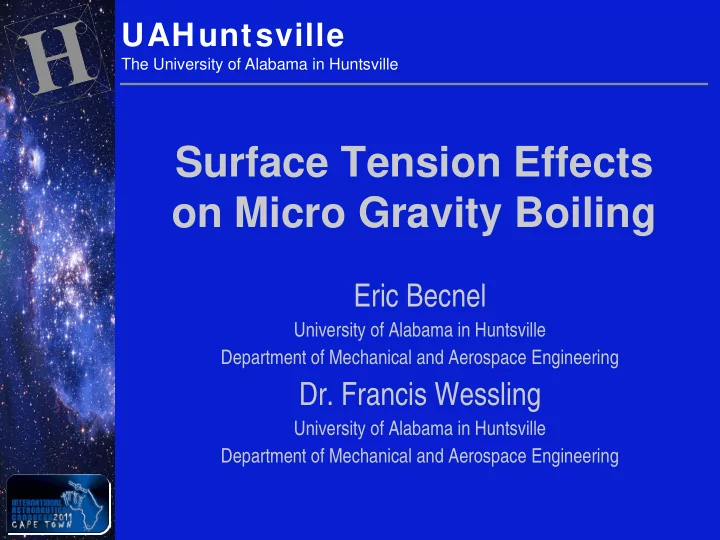

UAHuntsville The University of Alabama in Huntsville Surface Tension Effects on Micro Gravity Boiling Eric Becnel University of Alabama in Huntsville Department of Mechanical and Aerospace Engineering Dr. Francis Wessling University of Alabama in Huntsville Department of Mechanical and Aerospace Engineering
UAHuntsville Eric Becnel The University of Alabama in Huntsville edb0001@uah.edu Contents • Boiling regimes in gravity environment • Effect of micro-gravity environment • Purpose of instrument • CubeSat Parameters • Design of the Boiling Tube Figure 1: The Boiling Tube instrument, assembly
UAHuntsville Eric Becnel The University of Alabama in Huntsville edb0001@uah.edu Boiling Regimes 1 • Free Convection – Buoyancy driven fluid convection at heated surface – Exists until bubble formation begins • Nucleate – Isolated vapor bubble formation – Bubble interference and coalescence – Bubble departure – Exist until critical heat flux is reached • Film Boiling – Vapor blanket Figure 2: Isolated bubbles and bubble interference 1 Incorpera, Frank P., Davis P. Dewitt, Theodore L. Bergman, and Adrienne S. Lavine. “Fundamentals of Heat and Mass Transfer” John Wiley & Sons, Inc. (2007).
UAHuntsville Eric Becnel The University of Alabama in Huntsville edb0001@uah.edu Effect of Micro-Gravity • Minor free convection and conduction – Primary mode of heat transfer is limited convection due to small movement at the surface along with conduction through the fluid • Nucleate – Bubble formation – Bubble coalescence – Surface Roughness • Higher surface roughness increases heat transfer rate
UAHuntsville Eric Becnel The University of Alabama in Huntsville edb0001@uah.edu Intent of Instrument • To test six samples, each with a different surface roughness • Bubble dimensions are driven directly by the change in surface roughness by altering the surface tension. Changing the bubble dimensions should have a direct and considerable Figure 3: The Boiling Tube effect on the heat transfer in instrument, assembly micro-gravity.
UAHuntsville Eric Becnel The University of Alabama in Huntsville edb0001@uah.edu Measurements • Fundamental – Fluid Pressure • Derive saturation temperature – Surface temperature – Input voltage and Current • Derive surface heat flux • Additional – Fluid temperature – Images • Understand conditions during bubble formation Figure 4: The Boiling Tube and coalescence instrument, sensor configuration
UAHuntsville Eric Becnel The University of Alabama in Huntsville edb0001@uah.edu Why Test in Orbit? Pros Cons • Mission life allows time to • Limited data downlink stabilize and perform • No instrument recovery longer tests • Lower acceleration than sub-orbital options – Aerodynamic drag • Test multiple samples, multiple times
UAHuntsville Eric Becnel The University of Alabama in Huntsville edb0001@uah.edu CubeSat Parameters 2 • Constrained – Mass ~ 1kg – Size ~ 10cm Cube • Pressure vessels – Must be under 1.2 atmospheres (atm) – Factor of safety greater than 4 • Experiment dimensions – Sample dimensions • 5mm diameter an 10mm tall – Overall Instrument • Exterior is 30 x 30 x 56 mm • Water for working fluid Figure 6: The Boiling Tube – Liquid at 1 atm within the expected instrument, dimensions (mm) temperatures of storage and launch. – Availability 2 “CubeSat Design Specification” The Cubesat Program, Cal Poly SLO
UAHuntsville Eric Becnel The University of Alabama in Huntsville edb0001@uah.edu Heated Sample a) Heated resistor c • Produces heat for heated sample b b) Thermistor a • Measured to derive the surface temperature c) Suspending polymer strings Figure 7: The Boiling Tube instrument, heating sample • Mount the cylinder in the chamber securely
UAHuntsville Eric Becnel The University of Alabama in Huntsville edb0001@uah.edu Chamber a) Aluminum bulkheads a b) Upper support ring • Aluminum mounting b ring for samples in tension c c) Glass walls • Ease of inspection for assembly and testing d d) Electrical pass-through e • Epoxied wires for insulation and seal e) Lens Figure 8: The Boiling Tube a) Camera port for image instrument, assembly
UAHuntsville Eric Becnel The University of Alabama in Huntsville edb0001@uah.edu Boiling Curve ( ) 1 / 4 σ ρ − ρ Critical heat flux is reevaluated at g = ρ l v q " Ch υ ρ fg max 2 microgravity to determine maximum υ Equation 1: Critical heat flux 1 heat dissipation during the experiment. Figure 9: Typical boiling curve at 1atm and 1gravity. 3 3 Nukiyama, S., J. Japan Soc. Mech. Eng., “Int. J. Heat Mass Transfer, 9, 1419, 1966”.
UAHuntsville Eric Becnel The University of Alabama in Huntsville edb0001@uah.edu Performance on Orbit • Initial approximations of on-orbit performance is significantly affected by the local acceleration. • This local acceleration could be due to movement by satellite attitude changes or vibrations and can increase the critical heat flux.
UAHuntsville Eric Becnel The University of Alabama in Huntsville edb0001@uah.edu Results • The results of this experiment will expand the knowledge in the field of microgravity boiling. • With a low cost experiment platform, variations of the fluid and material samples can be flown in a cost effective manor.
UAHuntsville Eric Becnel The University of Alabama in Huntsville edb0001@uah.edu Acknowledgments • University of Alabama in Huntsville • Office of the Vice President for Research • Alabama Space Grant Consortium
Recommend
More recommend